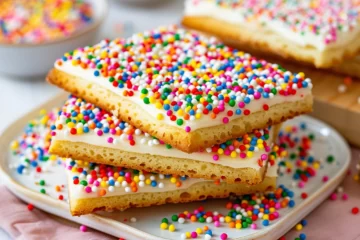Overcoming Writer’s Block in the Culinary World
Hello, fellow food lovers! Welcome to a space where we tackle a common challenge for anyone who spends time in the kitchen: recipe writer’s block. Just like writers of novels and poetry, we culinary enthusiasts also sometimes find ourselves staring blankly at our ingredients, wondering where our muse has gone. But fear not! This blog post is dedicated to reigniting that spark of creativity, with practical advice and exciting ideas to help you whip up your next great dish. So, let’s dive into the art of finding inspiration in the most familiar and surprising places!
Cooking is a form of art, and like all artists, chefs—both home and professional—occasionally hit creative blocks. These blocks can be frustrating, especially when you’re eager to try something new or impress at your next meal. Whether you’re dealing with a lack of motivation, feeling uninspired by your usual recipes, or just unsure where to start, this post will guide you through several strategies to overcome these hurdles.
The goal is not just to help you find a single idea but to equip you with techniques and inspiration sources that you can turn to time and again. From exploring the depths of your pantry to embracing the influences of global cuisines, we’ll cover a variety of approaches to ensure that your cooking creativity is never stifled for long. Let’s start with something as simple as looking through your pantry.

Table of Contents
Finding Inspiration in Your Pantry
Your pantry holds more potential than you might think. It’s often overlooked as just a storage space, but with a bit of imagination, it can become the starting point for culinary innovation. Here’s how you can turn pantry perusing into an inspiring activity:
- Check Dates and Rotate Stock: Start by organizing your pantry. Check expiration dates, bring older items to the front, and think about how you can use them creatively.
- Theme Ingredients: Pick a theme based on a single ingredient. For example, if you have multiple types of rice, could you explore different cultural dishes that use rice as a base?
- Create Flavor Profiles: Group ingredients by cuisine or flavor profiles. This might inspire you to mix commonly paired items in new ways or to experiment with new combinations.
Thinking creatively about your pantry staples can lead to surprising culinary developments. Imagine discovering that the lentils you’ve ignored could be the base for a delicious, spicy Indian dal, or that the assortment of nuts could be turned into a professional-grade pesto. Start viewing your pantry as a treasure trove of ingredients waiting to be transformed into your next great meal.
Moreover, a well-organized pantry helps reduce food waste by ensuring you use items you already have. It’s both economically and environmentally beneficial. Challenge yourself to make meals based on leftover ingredients at the end of the week—call it your “pantry purge” day. It’s a fun and practical exercise that pushes your creativity to the limits.

Out to Eat: Learning from the Pros
Dining out can be more than just a way to avoid cooking for the night. It’s an opportunity to learn and bring back ideas to your own kitchen. Next time you’re at a restaurant, really focus on what you’re eating. What herbs and spices can you detect? What cooking method was used? Chefs spend years perfecting their dishes, and each meal they serve is a lesson in balance and innovation. If something really strikes you, don’t hesitate to ask the staff about the ingredients or techniques used. Most chefs are flattered by the interest and happy to share tips that you can try at home.
- Take Notes: Bring a small notebook or use your phone to jot down what impresses you about the food. Is it the texture, the combination of flavors, or perhaps the presentation?
- Ask for Recipes: Sometimes, if you ask nicely, chefs are willing to share their recipes or tips, especially for dressings or marinades.
- Focus on Plating: The presentation can be just as inspiring as the taste. Note the colors, the arrangement on the plate, and how different elements complement each other.
Eating out is also a fantastic way to keep abreast of culinary trends. Chefs often experiment with ingredients and techniques that are on the cutting edge, which can provide you with fresh ideas to try at home. Moreover, understanding the thought process behind how dishes are constructed can deepen your appreciation of cuisine and inspire your own culinary creations.
Additionally, trying different types of restaurants, from high-end to local eateries, can offer a wide spectrum of culinary experiences. Each establishment brings its unique flair to dishes, often reflecting the cultural and personal backgrounds of the chefs. By exposing yourself to these diverse culinary environments, you not only enhance your palate but also expand your understanding of how food can be a form of communication, expressing traditions, innovations, and regional tastes.

Strolling Through the Supermarket
The supermarket can be your muse. Every aisle is packed with potential. Make your next grocery trip an adventure rather than a chore by paying attention to the seasonal produce or the international aisle. Challenge yourself to pick up a new ingredient each visit. Research it and experiment with it at home. This way, each shopping trip can become a source of inspiration. Additionally, reading labels can spark ideas. Maybe a sauce you pick up includes an herb you’ve never cooked with before—why not buy that herb fresh on your next visit?
- Explore the Exotic: Venture into sections of the market that are unfamiliar. Try out exotic fruits, vegetables, or pantry items that you haven’t used before.
- Seasonal Specials: Pay attention to seasonal produce that changes throughout the year. Seasonal cooking not only brings the freshest flavors to the table but also keeps your menu exciting and diverse.
- Product Packaging: Sometimes, packaging offers recipe ideas. These can be great starting points for new dishes, especially if you’re trying out an ingredient for the first time.
Supermarkets are also excellent places for culinary education. Many have bulletin boards or offer free magazines that include recipes and cooking tips. Some stores even host cooking demonstrations, which are perfect opportunities to learn new techniques and taste test before you buy. By making the most of these resources, you can turn every trip to the supermarket into a mini culinary lesson that fuels your creativity for days to come.
Moreover, supermarkets with a diverse array of international products can be particularly inspiring. If your local store has an international section, spend some time there. Pick up spices or condiments from different parts of the world and think about how you might incorporate them into your cooking. This not only adds new flavors to your dishes but also brings a piece of world culture into your kitchen.

Cultural Exploration Through Cuisine
One of the most enriching ways to expand your culinary horizons is to dive into the cuisines of other cultures. Choose a country and learn about its signature dishes. Use the internet to find authentic recipes, or better yet, books written by chefs from that region. As you cook, you’ll not only learn new techniques but also get a taste of the culture itself. Incorporating these new flavors and methods into your cooking can revive your interest and inspire entirely new dishes.
- Dedicate a Day: Make a ‘World Cuisine Day’ once a week where you cook a meal from a different country. This can be an exciting family activity or a personal culinary challenge.
- Use Authentic Ingredients: Whenever possible, use authentic ingredients rather than substitutes. This might mean a special trip to a gourmet store or ordering online, but it’s worth it for the authenticity of flavors.
- Cook with Friends: Invite friends who are from the country whose cuisine you are exploring. They can offer firsthand insights, traditional cooking tips, and maybe even family recipes.
Exploring international cuisines is not just about trying out new recipes; it’s about understanding the history and culture that shape these dishes. Each meal tells a story about its people, traditions, and the geography of the region. This deeper understanding can inspire a greater appreciation and a more authentic culinary practice at home.
Furthermore, learning about different cuisines can often introduce you to new cooking techniques. Whether it’s perfecting the Japanese art of tempura, mastering the fold of an Italian tortellini, or getting the spices just right in a Moroccan tagine, these skills can enhance your overall cooking repertoire. These new techniques not only add variety to your cooking but also improve your skills as a chef.

Turning to Cookbooks and Food Blogs
While it’s great to experiment, sometimes following a recipe can be just as creative. Dive into cookbooks—new or old—or scroll through food blogs. See how other food enthusiasts are mixing ingredients and maybe challenge yourself to modify a recipe to better suit your taste or the ingredients you have on hand. This can be a learning tool as well, helping you understand the foundations of recipe development. Also, participating in online food communities or following food bloggers can introduce you to new ideas and trends that can break any creative block.
- Curate Your Collection: Build a diverse cookbook library, including both modern gastronomy books and older, classic cookbooks. Each offers unique insights into the culinary arts.
- Interactive Cooking: Follow along with food bloggers who offer video tutorials. This can be particularly helpful if you’re trying a technique for the first time.
- Start a Cooking Blog: If you haven’t already, consider starting your own blog. This can be a great way to document your culinary experiments and connect with a community of like-minded enthusiasts.
Books and blogs not only provide recipes but also tell stories. Many cooks share personal anecdotes or cultural histories connected to their recipes, which can add an extra layer of interest to your cooking experience. Moreover, adapting recipes you find can help develop your ability to innovate. Maybe you substitute an ingredient due to a dietary restriction or personal preference, and suddenly you’ve created something new and exciting. This kind of adaptation encourages creative thinking and problem-solving, essential skills for any cook.
Additionally, the food blogging community is incredibly vibrant and supportive. Engaging with this community through comments, collaborative posts, or social media can provide a wealth of ideas and inspiration. It’s also a way to stay connected to culinary trends and innovations. As you become more involved, you may find opportunities for collaboration, such as guest posts or recipe exchanges, which can further expand your culinary horizons and inspire new content for your blog.

Engaging with Social Media and Food Forums
The digital world is a gold mine for culinary inspiration. Social media platforms and food forums buzz with innovation and creativity. Follow chefs, home cooks, and food bloggers. Engage in challenges posted online, which not only motivate you but also connect you to a community of like-minded individuals. Share your creations and ask for feedback. This interaction can provide new perspectives and ideas, fueling your creativity and perhaps even leading to collaborations.
- Join Groups and Forums: There are countless food-focused groups where members share recipes, cooking techniques, and food photography. Joining these can offer daily inspiration.
- Participate in Virtual Cook-offs: Many online communities organize virtual cooking contests or thematic cook-offs. These can be great motivators to try something new and stretch your culinary skills.
- Share Progressively: Don’t just post your successes; share your process. Sometimes, discussing what didn’t work can be just as helpful for you and others trying to learn.
Social media is particularly effective for keeping up with culinary trends and innovations. Platforms like Instagram or Pinterest are visual libraries of creative dishes and cooking techniques. By following these platforms, you can stay on the cutting edge of what’s new in the culinary world. Moreover, engaging with these communities can provide encouragement and validation, which is especially helpful when you’re experimenting with unusual recipes or techniques.
Additionally, participating in online challenges or events can rekindle your enthusiasm for cooking. These events often encourage participants to explore specific themes or ingredients, pushing their boundaries and introducing them to new concepts. Even if you don’t win a contest, the experience is invaluable. You’ll learn, you’ll create, and most importantly, you’ll have fun.

Hosting a Recipe Swap Meet
Organizing a recipe swap is a fantastic way to engage directly with a community of food lovers. Whether it’s through a local meet-up or an online group, exchanging recipes can expose you to dishes and techniques you might never have encountered otherwise. Make each swap meet special by choosing a theme—like holiday foods, appetizers, or desserts—which can guide the kind of recipes people bring and the discussions that ensue.
- Organize Regularly: Setting up a regular schedule for your swaps can help build a committed community. Whether it’s monthly or quarterly, consistency helps.
- Virtual Swap Options: If in-person meetings aren’t possible, consider a virtual swap. Use a platform like Zoom to share recipes and even cook together online.
- Expand Your Network: Invite new people each time or ask participants to bring a friend. This can diversify the recipes shared and increase the educational value of each meeting.
Recipe swaps are more than just fun social events; they are learning opportunities. They allow you to see firsthand how others approach cooking, which can offer new techniques and ideas that you may not have considered. Plus, discussing recipes and cooking methods with others can clarify your own thoughts and strategies, leading to better and more innovative cooking.
Moreover, recipe swaps can lead to unexpected culinary discoveries. Perhaps someone brings a family recipe that has been passed down through generations, offering a unique glimpse into their heritage and traditions. These stories add depth and meaning to the dishes, making cooking them an even richer experience. Through these exchanges, you not only expand your recipe repertoire but also build meaningful connections within your community, enriching your culinary journey.

Mindful Cooking: Relax and Rejuvenate
Sometimes, the best way to overcome a block is to take the pressure off. Cooking doesn’t always have to be about the end result. Make the process mindful and meditative by focusing on the sensory experiences—the aroma of herbs, the sizzle of the pan, the textures of ingredients. Play some calming music, take your time to feel each ingredient, and let your instincts guide you. This relaxed approach can open up new avenues of creativity without the stress of perfection.
- Engage All Your Senses: Pay attention to the colors, smells, and textures as you cook. This can make the process more enjoyable and less of a task.
- Embrace the Silence: Try cooking in silence now and then. This allows you to really focus on what you’re doing and can be surprisingly calming and inspiring.
- Reflect on the Experience: After cooking, take a moment to reflect on the experience. What did you enjoy? What would you do differently next time?
Mindful cooking can transform the kitchen from a place of stress to a sanctuary of peace. When you’re not rushed and can truly engage with the cooking process, you’re more likely to try new things and enjoy yourself. This kind of cooking doesn’t just feed the body; it nourishes the soul, making each meal a celebration of being present and alive.
Moreover, this approach allows you to experiment with new ideas without fear of failure. When the focus is on the process rather than the perfect outcome, you can explore different spices, ingredients, and techniques with an open mind. This freedom often leads to innovative dishes and can rekindle your love for cooking.

Experimentation and Play in the Kitchen
Don’t be afraid to fail—it’s just a step towards a fantastic recipe. The kitchen is your lab, and every ingredient offers a chance to discover something new. Swap out spices, mix up marinades, and see what happens when you apply different cooking techniques to familiar foods. Not every experiment will be a success, but each attempt will teach you more about how flavors and textures combine. Plus, it’s just plain fun to see what you can come up with when you throw the recipe book out the window!
- Keep a Culinary Journal: Document your experiments. Note what works and what doesn’t. This journal can become a valuable resource over time.
- Involve Others: Cook with friends or family. They might offer new ideas or variations that you hadn’t considered.
- Stay Curious: Always ask, “What if?” What if you added some cocoa to that chili? What if you roasted those vegetables instead of boiling them?
Experimentation is the heart of culinary creativity. It’s about trying new combinations, pushing the boundaries of traditional cooking, and not being afraid to fail. Each failure is an opportunity to learn and grow as a chef. By adopting a playful and experimental attitude, you can turn your kitchen into a space of endless creative possibilities.

FAQs on Overcoming Recipe Writer’s Block
To wrap things up, let’s address some common questions:
- What if I run out of ideas? Go back to basics. Choose a simple ingredient and think about all the ways you can prepare it.
- How do I make my dishes unique? Think about a ‘signature’ element, like a spice or cooking technique, and try to incorporate it whenever appropriate.
- What if I fail? Each failure is packed with lessons. Take note of what didn’t work, adjust, and try again. Remember, even the world’s best chefs have had their fair share of flops.
Conclusion: Keep Cooking and Creating
There you have it—a myriad of ways to find inspiration and overcome the culinary equivalent of writer’s block. Remember, every cook, whether professional or home enthusiast, encounters creative hurdles. The key is to keep exploring, experimenting, and enjoying the process. With the strategies we’ve shared today, you’re equipped to continue your culinary adventures with renewed vigor and boundless creativity. So, keep those pots simmering and let your culinary imagination soar!
This expanded content should provide your readers with a deeper understanding and more comprehensive guidance on navigating through and beyond the culinary creative blocks, enriched with practical tips and personal encouragement.
Kitchen Gear and Equipment We Use and Love
I just wanted to let you know that some of the links on this page are affiliate links. This means that if you click on these links and make a purchase, I may earn a small commission at no extra cost to you. Rest assured, I only recommend products and services that I personally use and love. Your support through these links helps me continue to create valuable content and keep this blog running. I appreciate your support!















